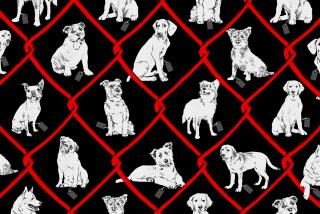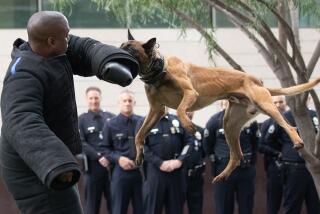Breeders Hope Court Will Defang New Shepherd’s Critic
- Share via
BERLIN — Helmut Raiser wants the German shepherd to be plebeian and muscular, not a lithe, curvy creature preening and prancing for blue ribbons at dog shows.
This aesthetic desire sparked a dog war when Raiser -- the beleaguered breed warden for the national German Shepherd Assn. -- criticized some kennels for turning out generations of shepherds that looked less like working dogs and more like weak-backed wimps with no calluses on their paws and no grit to their personalities.
This new shepherd, he said, “is a dog in the front and a frog in the back, walking around with a retracted backside as if a brick-stone is hanging from its testicles.... The worst is the emptiness in the heads of these dogs, and the boring and stupid expressions on their faces.”
The ensuing growls have yet to quiet.
“Raiser’s acting like a dictator,” said Clemens Lux, manager of the German Shepherd Assn. based in Augsburg. “We are very sad about it.”
In a sense, this dust-up of ego, politics and science reflects the stoicism and spirit with which many Germans define national identity. Like Johann Wolfgang von Goethe, Richard Wagner and Martin Luther, the shepherd has a cherished meaning in the wider German culture. The dog -- used by police, rescue teams and the blind -- epitomizes a strict work ethic and shows how perseverance leads to excellence.
The debate has turned into a symbolic struggle of sorts between the working and the well-heeled classes. Wealthier shepherd owners, Raiser says, have flocked to the show dog market, even enticing east German breeders, who before the fall of the Berlin Wall bred utilitarian working dogs for border guards and armies. The result, he says, is a delicate, more urbane shepherd with a slanting back and bad hips that mocks the ideals of Max von Stephanitz, who first organized breeders in the late 1890s.
The most recent storm around the shepherd -- the dog’s appearance has been argued over for years -- has veered in and out of court since December 2002, when Raiser was elected breed warden, a post that influences canine guidelines across Germany. Raiser’s detractors -- whom he calls “that old show dog mafia” -- have twice attempted to unseat him. A court ruling on Raiser’s fate is expected in May.
One of Raiser’s critics is show dog breeder Juergen Wicht.
“My shepherds are obedient,” said Wicht, manager of Team Fiemereck kennels in Bamberg. “They are good workers. They train hard for their titles. Raiser has no idea about breeding. He likes controversy, and he’s hurting the image of the German shepherd around the world. If you have a product, you don’t talk badly about it.”
Raiser scoffs.
“There’s a lot of money in show dogs,” he said. “The show people want part of this big cake. They’ve destroyed a lot in the last 30 years. They’re producing a lot of German shepherds not worthy of being called working dogs. These dogs have lost their drive and intellectual capacity.”
He added: “The anatomy of this new dog has no function. It’s handicapped.... It’s like if your name was Mitsubishi or DaimlerChrysler. You can’t ruin your product. We had the name of the best working dog in the world, then suddenly we had fashion.”
Wicht bristles at the suggestion. “Raiser and his followers are envious. My dogs have no problems with their hips.”
Lux said Raiser was exaggerating the problems and draping himself in canine righteousness. The German Shepherd Assn., Lux said, has 80,000 members and recognized in the late 1990s that breeding practices by some kennels had to be curbed because their methods were producing “unnatural” dogs. He said only 5% of breeders fit this category.
A top shepherd show dog can sell for about $250,000, compared with about $5,500 for a pedigree working dog.
“We are working against it,” said Lux, adding that show dogs with exaggerated features no longer consistently win honors, which will in turn reduce their stud fees and eventually diminish the breed.
“We saw that these dogs can’t go a long time with the severe angulations. In the hind section, they are very weak,” he said.
The slanting dogs were a sensation years ago when pictures of them arrived from the U.S. and Britain.
“Germans like things from the outside,” Lux said. “Germans said, ‘That’s wonderful. They’re so good-looking.’ Many didn’t think that the shepherd is a working dog.... It’s a question now of [how] to reverse the trend. Mr. Raiser’s way is ridiculous and very radical. He wants to put dogs he doesn’t like immediately out of breeding. But you have to go slowly with breeding cycles.”
Raiser, who says the dog community considers him either the “messiah, or the devil,” wants to purify the bloodlines and restore the pedigree in the 20,000 shepherd pups born each year in Germany.
“The danger is the health of the dog,” he said. “Today’s dogs are old by the time they’re 4 or 5 years old. They have problems with their spines, skin and fitness. Ask a policeman. They’ll tell you these new shepherds can’t walk more than four hours. Blind people won’t use them because they’re unstable.”
Seldom at a loss for words, Raiser summed up: “The old show dog camp hope they make me frustrated so I quit. This is war.”
*
Petra Falkenberg in The Times’ Berlin Bureau contributed to this report.
More to Read
Sign up for Essential California
The most important California stories and recommendations in your inbox every morning.
You may occasionally receive promotional content from the Los Angeles Times.











